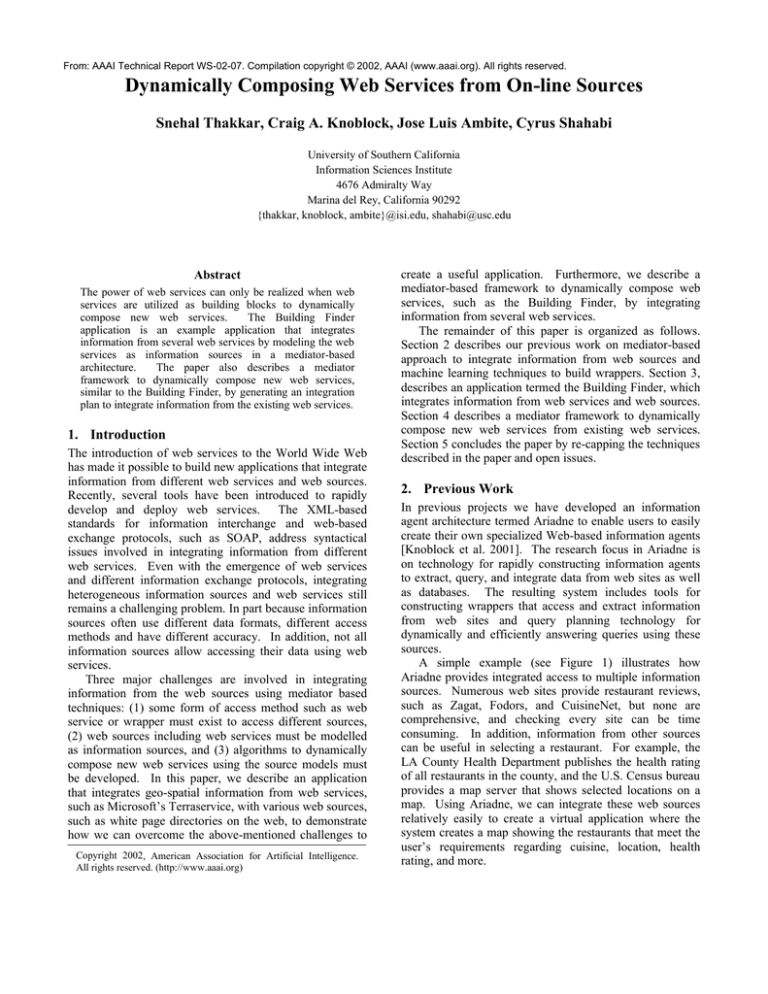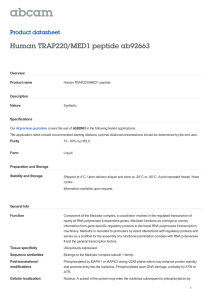
From: AAAI Technical Report WS-02-07. Compilation copyright © 2002, AAAI (www.aaai.org). All rights reserved.
Dynamically Composing Web Services from On-line Sources
Snehal Thakkar, Craig A. Knoblock, Jose Luis Ambite, Cyrus Shahabi
University of Southern California
Information Sciences Institute
4676 Admiralty Way
Marina del Rey, California 90292
{thakkar, knoblock, ambite}@isi.edu, shahabi@usc.edu
Abstract
The power of web services can only be realized when web
services are utilized as building blocks to dynamically
compose new web services.
The Building Finder
application is an example application that integrates
information from several web services by modeling the web
services as information sources in a mediator-based
architecture.
The paper also describes a mediator
framework to dynamically compose new web services,
similar to the Building Finder, by generating an integration
plan to integrate information from the existing web services.
1. Introduction
The introduction of web services to the World Wide Web
has made it possible to build new applications that integrate
information from different web services and web sources.
Recently, several tools have been introduced to rapidly
develop and deploy web services. The XML-based
standards for information interchange and web-based
exchange protocols, such as SOAP, address syntactical
issues involved in integrating information from different
web services. Even with the emergence of web services
and different information exchange protocols, integrating
heterogeneous information sources and web services still
remains a challenging problem. In part because information
sources often use different data formats, different access
methods and have different accuracy. In addition, not all
information sources allow accessing their data using web
services.
Three major challenges are involved in integrating
information from the web sources using mediator based
techniques: (1) some form of access method such as web
service or wrapper must exist to access different sources,
(2) web sources including web services must be modelled
as information sources, and (3) algorithms to dynamically
compose new web services using the source models must
be developed. In this paper, we describe an application
that integrates geo-spatial information from web services,
such as Microsoft’s Terraservice, with various web sources,
such as white page directories on the web, to demonstrate
how we can overcome the above-mentioned challenges to
Copyright 2002, American Association for Artificial Intelligence.
All rights reserved. (http://www.aaai.org)
create a useful application. Furthermore, we describe a
mediator-based framework to dynamically compose web
services, such as the Building Finder, by integrating
information from several web services.
The remainder of this paper is organized as follows.
Section 2 describes our previous work on mediator-based
approach to integrate information from web sources and
machine learning techniques to build wrappers. Section 3,
describes an application termed the Building Finder, which
integrates information from web services and web sources.
Section 4 describes a mediator framework to dynamically
compose new web services from existing web services.
Section 5 concludes the paper by re-capping the techniques
described in the paper and open issues.
2. Previous Work
In previous projects we have developed an information
agent architecture termed Ariadne to enable users to easily
create their own specialized Web-based information agents
[Knoblock et al. 2001]. The research focus in Ariadne is
on technology for rapidly constructing information agents
to extract, query, and integrate data from web sites as well
as databases. The resulting system includes tools for
constructing wrappers that access and extract information
from web sites and query planning technology for
dynamically and efficiently answering queries using these
sources.
A simple example (see Figure 1) illustrates how
Ariadne provides integrated access to multiple information
sources. Numerous web sites provide restaurant reviews,
such as Zagat, Fodors, and CuisineNet, but none are
comprehensive, and checking every site can be time
consuming. In addition, information from other sources
can be useful in selecting a restaurant. For example, the
LA County Health Department publishes the health rating
of all restaurants in the county, and the U.S. Census bureau
provides a map server that shows selected locations on a
map. Using Ariadne, we can integrate these web sources
relatively easily to create a virtual application where the
system creates a map showing the restaurants that meet the
user’s requirements regarding cuisine, location, health
rating, and more.
MapBlast! &
Etak Geocoders
property value, and phone number for the houses in the
area of interest. Section 3.1 describes detail information
about the web sources integrated by the Building Finder
application.
Section 3.2 describes our approach to
integrate the information from these sources.
Tiger
Map Server
3.1. Web Sources and Services
Ariadne
The building block services for the Building Finder
application consist of following:
Agent
•
Fodor’s
Health Ratings
Zagat
Figure 1 Ariadne Mediator: Example
Application
An essential component of Ariadne is a wrapper around
each individual data source, which provides uniform access
to the information sources so that they can be queried as if
they were relational databases. We have developed
machine learning techniques to build wrappers around
websites with relatively minimal user assistance [Knoblock
et al. 2001b]. Using our wrapper building tools, we have
developed several wrappers around popular web sources of
different categories, such as the CNN website for news
information and Yahoo Weather for weather related
information.
In Ariadne the mediator designer defines a domain
model, which is an ontology of the application domain that
integrates the information in the sources and provides a
single terminology over which the user poses queries. The
domain model is represented using the Loom knowledge
representation system [MacGregor 1988]. Each information
source is defined described using the terms in the domain
model [Arens et al. 1996; Knoblock et al. 2001]. The
source descriptions are utilized to reformulate user queries
into source queries.
We have also developed Theseus, an efficient execution
system for information agents [Barish et al. 2000]. More
specifically, Theseus empowers users by (a) simplifying the
process of specifying agents that can manage and monitor
dynamic data sources, such as web sites, and (b) providing
a flexible, optimised platform for agent execution. Theseus
allows users to specify a query execution plan to build a
new information agent by using existing information
agents.
3. The Building Finder Application
The Building Finder application allows a user to input
an area of interest and provides a satellite image of the area
with the houses and streets superimposed on the satellite
image. Furthermore, the Building Finder also provides
additional information such as name of the person, address,
•
•
•
•
•
Microsoft TerraService: TerraService provides access
to a large repository of satellite images and
topographic maps covering most of United States and
Canada [Barclay et al. 1999]. The maps and satellite
images provided by TerraService are from the United
States Geological Survey (USGS). More information
on TerraService can be found at http://terraservice.net.
USGS Landmark web service: The USGS Landmark
Service is also a part of Microsoft TerraService and
provides access to landmark point across continental
United States. The landmark points provided by this
service are also provided by USGS.
Tigerline files: The U.S. Census Bureau provides a
comprehensive list of streets, zip codes and cities in
form of the Tigerline files. The Tigerline files can be
downloaded from U.S. Census Bureau’s web site. We
have downloaded the Tigerline files to our database.
The SwitchBoard white pages: SwitchBoard white
pages are located at http://www.switchboard.com. The
SwitchBoard white pages provide listing of all
residential phone numbers and other information from
United States.
Geocoder: Geocoder provides geographic coordinates
for a given address. Several geocoders such as Etak are
available on the web. However, most of the geocoders
are off by as much as half block and do not provide
any bounds on accuracy. We built a geocoder that
provides more accurate geographic coordinates by
integrating information from various web sources.
Real Estate Property tax sites: The assessor’s
department in various counties and cities provide online information about different properties in the
county or city. The information provided by the
property tax sites include assessed value for the
property, estimated property tax, and dimensions of the
property. Various property tax sites have different
coverage and provide different data. For example.
USPDR located at http://www.uspdr.com provides
property information for the state of New York, while
the Los Angeles county assessor’s department website
located at http://assessor.co.la.ca.us/DataMaps/pais.asp
provides information about properties in Los Angeles
county.
The Building Finder application finds
property values from several property tax web sites.
Figure 2 shows the organization of different property
tax sites and coverage for each property tax site.
US Property Tax Sites
NY
……
CA
Riverside ……
LA
Figure 2 Property Tax Sites
The Building Finder utilizes the following access
methods to obtain information from different data sources:
(1) wrappers to extract structured information from the
SwitchBoard white page web source and the various
property tax sites, (2) SOAP and XML to access satellite
imagery and points of interest from Microsoft TerraService
and Landmark web services, respectively, and (3) a
database query to access information from Tigerlines
database.
The SwitchBoard white pages site and various property
tax sites were wrapped using our wrapper building tools.
Once a wrapper is built, the system can treat each web
source as a database, i.e., the system can send queries to the
SwitchBoard white page wrapper such as, “find all people
in the city of El Segundo whose last name starts with the
letter A”. The wrapper returns an XML document that
contains the results of the query.
XML web services are web applications that support
standard protocols such as SOAP and XML. Terraservice
provides access to a large repository of satellite images and
topographic maps using SOAP and XML protocols
[Barclay et al. 1999]. The Landmark service allows easy
access to the USGS gazetteer, which provides important
points such as hospitals, schools, and churches in the
United States. The Building Finder provides area of
interest to Microsoft TerraService web service through
SOAP messages and receives a satellite image from the
web service through a SOAP message. Similarly, the
Building Finder also queries the USGS landmark points
from the Landmark web service. The issue however is how
to integrate the imagery obtained from the Terraservice, the
address information obtained from the white page data, and
information from various property tax sites.
3.2. Integrating Web Source and Services
The Building Finder integrates information from the
sources described in Section 3.1. Figure 3 shows the
architecture for the Building Finder application. The
Building Finder receives the region of interest as input
from the user and queries the streets from a Tigerlines
database containing street network information to find all
streets in the region of interest. The result of the query is a
set of tuples consisting of street name, city, state and zip
code, which are used to query the Switchboard white page
wrapper to find all the addresses on the streets. The result
Figure 3 Building Finder Application Architecture
Figure 4 Screenshot of the Building Finder in Action
of the Switchboard white pages website is then provided to
the geocoder agent, which provides the geographic
coordinates for the addresses. The region of interest is also
used to query Microsoft TerraService for a satellite image.
The Building Finder application finds the property
values for all addresses found from the SwitchBoard White
pages by querying different property tax sites. A naïve
approach would be to send all addresses to all property tax
web sites. However, this naïve approach requires a large
number of queries to various property tax sources. The
Building Finder application first finds the county for each
address by providing city and state information from each
address to the National Association of Counties (NACO)
web site that provides the county information for each city.
The county information is used to determine which
property tax site should be queried for each address. The
results from various property tax sites are combined to
produce property value information for each address.
Finally, the latitude and longitude points representing
different addresses and information about the addresses are
superimposed on the satellite imagery. Figure 4 shows a
screen shot of the Building Finder application in action.
The Building Finder application provides the abovementioned plan to the Theseus execution system, which
efficiently executes the plan and obtains the results from all
the web sources. The Theseus execution system utilizes a
dataflow architecture to execute the independent steps in
the integration plan in parallel. For example, Theseus can
find satellite image from Microsoft TerraService in parallel
with querying streets from the Tigerlines database.
Furthermore, the Theseus execution system allows a wide
range of access methods to different types of data sources
[Barish et al. 2000].
4. Mediator-based Approach to Web Service
Integration
The Building Finder application successfully integrates
information from several web services and sources.
However, the integration plan for the Building Finder
application is pre-defined and very limited. A mediatorbased approach can be utilized to dynamically compose
new web sources similar to the Building Finder application.
The Information integration literature includes a wide
variety of mediator systems [Wiederhold 1996], such as the
Information Manifold [Levy et al. 1996], InfoMaster
[Genesereth et al. 1997], InfoSleuth [Bayardo Jr. et al.
1997], and Ariadne [Knoblock et al. 2001]. All of the
above-mentioned systems can answer specific user queries
by integrating information from various information
sources, for example, find property values for all properties
in Los Angeles, California where ‘John smith’ resides. The
goal of the mediator framework described here is not only
to answer the user queries, but also to generate a new web
service that can answer similar user queries by integrating
information from several web sources. So, the mediator
framework needs to generate an integration plan for a
template query, e.g. find property values in a given city
where a given person resides. The mediator framework
generates a new web service that can execute the
integration plan for template query to answer similar user
queries. The mediator framework utilizes the Theseus
[Barish et al. 2000] execution system to execute the
integration plans.
Section 4.1 describes how the information sources are
modelled in the mediator’s domain model. Section 4.2
describes the algorithm to reformulate user queries into
source queries.
4.1. Modeling Web Sources
At the heart of any mediator system is the language utilized
to describe the source models. The ability to define
complex source models provides a good backbone for the
mediator system. The mediator system built here utilizes
source models similar to source models utilized by the
Ariadne mediator system [Knoblock et al. 2001]. The
sources are described by a set of binding patterns for the
source, a set of inputs, a set of outputs provided by the
source, and a set of constraints that describe the source. For
example, a geocoder accepts a street address, a city, a state
and a zip code as input parameters and provides latitude
and longitude for the given address. In addition to the
binding constraints a geocoder web source may have other
constraints related to the data that the geocoder provides.
For example, the geocoder may be able to only geocode
addresses in the state of California. As a part of the source
description the mediator models the constraints on the
sources as well. Figure 5 shows the model of a geocoder
web source that can geocode addresses in the state of
California.
The mediator system built here utilizes an attributelevel ontology to relate different source models with the
domain model. The attribute-level ontology provides a
relationship between the attributes in the mediator’s
domain model and the attributes provided and accepted by
the sources. The attribute level ontology provides a simple
way to determine how the sources relate to the mediator’s
domain model and how the sources are related to each
other. The attributes for each source also determine the
class of the source, for example, the name attribute for a
white page source that describes a person name, must be
classified differently than the name attribute for a yellow
page source that describes a company name.
Geocoder ($state = ‘CA’)
$Street Address
$City
$State
Lat
Lon
Figure 5 Source Model for Geocoder
4.2. Reformulating User Queries
The mediator can utilize the source models to reformulate
user queries into the source queries. The mediator utilizes a
forward chaining algorithm to construct an integration plan
consisting of a set of source queries. Next, the mediator
optimises the integration plan using a data flow analysis
algorithm. Finally, the mediator utilizes the source
constraints to filter the data at the tuple level.
4.2.1. Forward Chaining Algorithm
The mediator system receives a list of inputs provided by
the user and a list of outputs requested by the user. The
system initialises set of sources to empty set. First, the
mediator finds all sources whose binding patterns can be
satisfied with the inputs from the list of inputs, add those
sources to the list of sources. Next, the mediator adds the
outputs of the sources from previous step to the list of
available outputs and list of inputs. Next, the mediator
checks to see if all requested outputs are present in the list
of available outputs. If all requested outputs are not present
in list of available outputs the mediator repeats the process
with a new list of inputs till all requested outputs are
present in the list of available outputs. Figure 6 shows the
forward chaining algorithm.
4.2.2. Dataflow Analysis Algorithm for Optimisation
In order to reduce the number of queries sent to the source,
the mediator system must optimise the plan generated by
the forward chaining algorithm. The mediator performs
dataflow analysis to remove unnecessary source queries
from the generated plan. The algorithm begins with set of
outputs and finds all the sources that generate at least one
output in the list of outputs. Next, the inputs to the selected
UI = Set of User Inputs
UO = Set of Requested Outputs
AI = Set of Available Inputs
AS = Set of Available Sources
AO = Set of Available Outputs
ForwardChaining(UI, UO)
1. AI = Φ, AO = Φ, AS = Φ
2. AI = UI
3. {∀S(I,O,C) | ( I n AI = Φ)} Repeat
4.
AI += O
5.
AO += O
6.
AS += S
7.
If (AO n UO != Φ) Go to 3
Figure 6 Forward Chaining Algorithm
sources are added to the list of outputs and the process is
repeated till no more sources can be found in step 1. The
resulting list of sources is the minimal set of sources that
answers the user query.
4.2.3. Tuple Level Filtering
In addition to the dataflow analysis, the mediator also
performs tuple level optimisation. The mediator starts the
tuple level optimisation with a list of sources and source
constraints for each source. The mediator inserts a filtering
condition before each source query to filter out the rows
Find property value for
properties where John Smith
lives
that do not meet the source constraints. For example, in the
case of the geocoder that can only geocode addresses in
California, the mediator inserts a filtering condition that
filters out all addresses that are not in the state of
California. This feature can be very useful when the
several sources provide similar data, but cover different
regions. In the case of the integration plan for the Building
Finder application tuple level filtering is very useful. If the
user query were to find properties for all people with name
‘John Doe’, the traditional mediators would generate an
integration plan where all property tax sources will be
queried for all records found from the SwitchBoard White
Pages.
Our mediator framework, analyses the source models
for different property tax sources. The source models for
the property tax sources have constraints based on the
county, for example, the Los Angeles County property tax
source has a constraint that the input address must be in
Los Angeles County. The mediator determines that the
NACO web source can provide county information for
each address and queries the NACO counties site to find
the county information for each address. The mediator
introduces a filter that routes the addresses from the
SwitchBoard white pages to different property tax sites
based on the county information, similar to the
discrimination matrix described in the [Ashish et al. 1997].
Figure 7 shows a fragment of the integration plan where the
mediator framework generates a plan that queries the Los
SwitchBoard
White Pages
List of people with
following attributes:
name, street address,
city, state, zip,
phone
Los Angeles
County Property
Tax Site
Property
Values
…………….
Dallas
County Property
Tax Site
NacoCityto
County
Augment list of
people with county
information
LA
Cou
nty
……..
las
Dal
Figure 7 Partial Integration Plan
nty
Cou
Filter
Angeles property tax source for all records found from the
SwitchBoard that are in the county of Los Angeles, queries
the San Francisco property tax source for all records found
from the SwitchBoard that are in the county of San
Francisco and so on.
The plan generated by the mediator is a universal
integration plan, similar to the universal plans described in
the [Shoppers 1987], that can answer not only the user
query, but also all queries with similar structure. For
example, the integration plan shown in Figure 7, can
answer the query find property values for properties where
the given person lives. Once the universal integration plan
has been generated it can be used to generate a new web
service for all possible values of the input parameters.
5. Discussion
In this paper, we described the Building Finder application,
which integrates information from several web services to
find buildings in satellite imagery and related information
for the buildings. We described a mediator framework that
models the web services as information sources and
dynamically composes new web services, such as the
Building Finder by generating a universal integration plan
to answer the user queries.
[Genesereth et al. 1997] Genesereth, M. R., Keller, A. M.
and Duschka, O. M. 1997. Infomaster: An Information
Integration System. In Proceedings of ACM SIGMOD-97
[Knoblock et al. 2001] Knoblock, C., Minton, S., Ambite,
J.L., Ashish, N., Muslea, I., Philpot, A. and Tejada, S.
2001. The Ariadne Approach to Web-Based Information
Integration. International Journal on Intelligent
Cooperative Information Systems (IJCIS) 10(1-2): 145-169
[Knoblock et al. 2001b] Knoblock, C. A., Lerman, K.,
Minton, S. and Muslea, I. 2001b. Accurately and Reliably
Extracting Data from the Web:A Machine Learning
Approach. IEEE Data Engineering Bulletin 23(4): 33-41
[Levy et al. 1996] Levy, A. Y., Rajaraman, A. and Ordille,
J. J. 1996. Query-Answering Algorithms for Information
Agents. In Proceedings of AAAI-96
[MacGregor 1988] MacGregor, R. 1988. A Deductive
Pattern Matcher. In the Proceedings of the Seventh Nation
Conference on Artificial Intelligence, Saint Paul,
Minnesota
References
[Arens et al. 1996] Arens, Y., Knoblock, C. A. and Shen,
W. M. 1996. Query Reformulation for Dynamic
Information Integration. Journal of Intelligent Information
systems, Special Issue on Intelligent Information
Integration 6(2/3): 99-130
[Ashish et al. 1997] Ashish, N., Knoblock, C. A. and Levy,
A. 1997. Information Gathering Plans with Sensing
Actions. European Conference on Planning, ECP-97,
Toulouse, France
[Barclay et al. 1999] Barclay, T., Gray, J. and Stuz, D.
1999. Microsoft Terraserver: A Spatial Data Warehouse,
Microsoft Corporation
[Barish et al. 2000] Barish, G., DiPasquo, D., Knoblock, C.
A. and Minton, S. 2000. A Dataflow Approach to AgentBased Information Management. In Proceedings of the
2000 International Conference of on Artificial Intelligence,
Las Vegas, NV
[Bayardo Jr. et al. 1997] Bayardo Jr., R. J., Bohrer, W.,
Brice, R., Cichocki, A., Flower, J., Helal, A., Kashyap, V.,
Ksiezyk, T., Martin, G., Nodine, M., Rashid, M.,
Rusinkiewicz, M., Shea, R., Unnikrishnan, C., Unruh, A.
and Woelk, D. 1997. Infosleuth: Agent-Based Semantic
Integration of Information in Open and Dynamic
Environments. In Proceedings of ACM SIGMOD-97
[Shoppers 1987] Shoppers, M. 1987. Universal Plans for
Reactive Robots in Unpredictable Environments.
Proceedings of the InternationalConference on Artificial
Intelligence, IJCAI-87
[Wiederhold 1996] Wiederhold, G. 1996. Intelligent
Integration of Information, Kluwer





